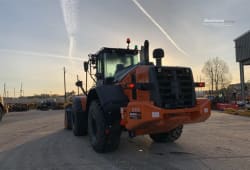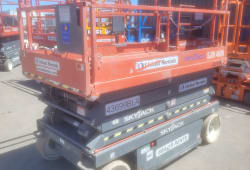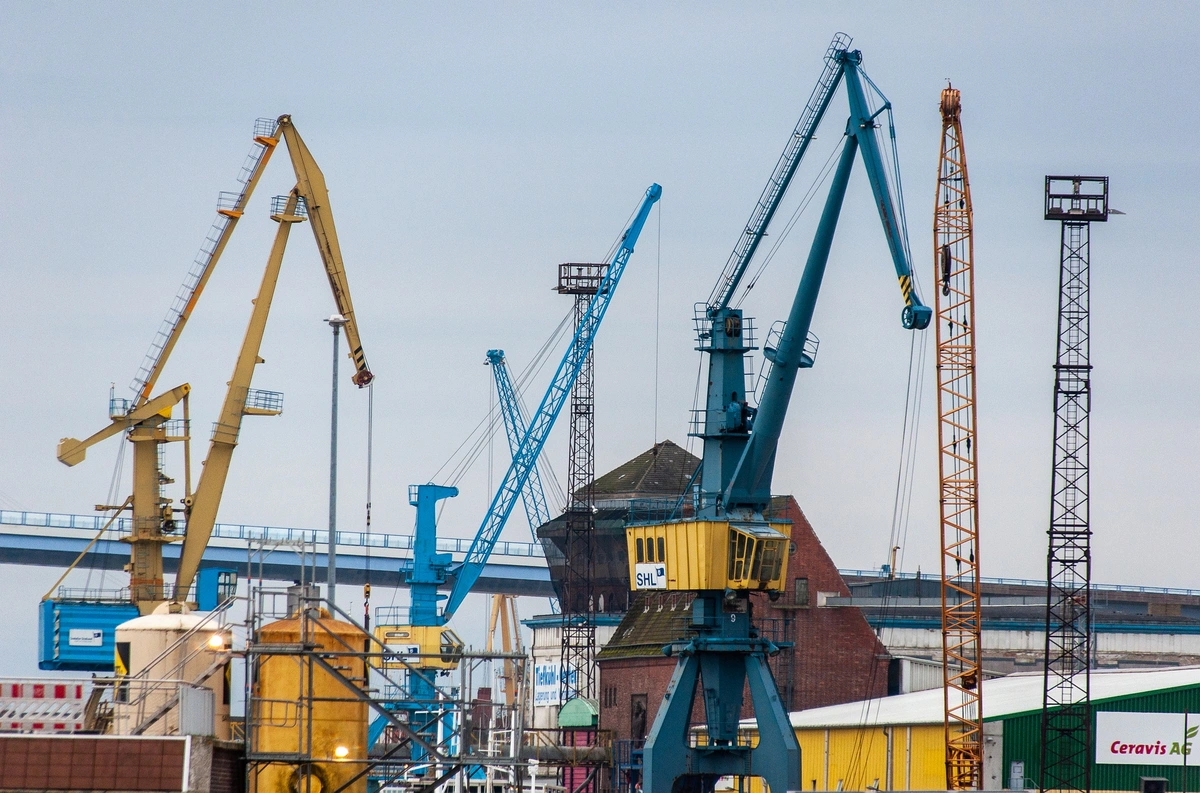The Benefits of Crane Construction for Building Projects
10 Min read
)
June 20, 2023
Cranes include introduction performance, productiveness, role, and flexibility when they entail introduction projects. These massive quantities of the systems are designed to address heavy hundreds and maneuver them to unreachable heights and regions. In this newsletter, we can speak about the blessings of crane manufacturing for building responsibilities and learn about various forms of cranes, their smooth additives, and how they function on manufacturing websites.
Understanding Crane Construction
Before we delve into the advantages of using cranes in production tasks, it's vital to understand their production. Cranes are a crucial part of any creation challenge. They are available in several kinds, like tower, cellular, and rough terrain cranes. Truck-mounted cranes, crawler cranes, and static cranes are terrific. Telescopic growth, truck-set-up cranes, and lattice growth are all designed for specific purposes and packages.
The tower crane is the most extensively used in excessive-rise construction production. Its tall form permits it to acquire first-rate heights and quickly deliver and flow into heavy loads. The cell crane, on the other hand, is used for transferring heavy masses on introduction internet websites. Its mobility and flexibility make it a terrific choice for several construction obligations. Crawler truck cranes are also used for excavation and earthmoving duties, and overhead cranes are typically used for commercial enterprise packages and fabric dealing.
Essential Components of a Crane
Regardless of the shape of the crane, all cranes have 4 simple components: the bottom, mast, slewing unit, and operator's cab. The base is the muse of the crane and offers stability. The mast holds the crane's weight and provides a valuable resource for its primary growth. The slewing unit allows the crawler crane to rotate, even as the operator's cab is wherein the crane operator controls the crane.
The crane's growth is the prolonged, horizontal arm that extends from the mast. It is attached to a hook or other lifting gadgets that could pass the horizontal beam up and down or facet to facet, relying on the crane's format and cause. The boom is made from several sections that may be extended or retracted to increase or decrease its duration.
How Cranes Operate on Construction Sites
Cranes are installed on a stable or rail-based platform and operate using hydraulic, mechanical, or electric power. The crane's arm is connected to a hook or unique lifting gadgets, allowing an all-terrain crane to move up and down or factor to factor, depending on the crane's format and purpose.
The static crane operator controls the crane from the operator's cab using a chain of levers, pedals, and buttons. The operator must have a smooth view of the crane's surroundings and be able to talk with different personnel on the development task net web page.
Cranes are crucial to any construction mission, and they require specialized training and knowledge to perform properly and efficiently. Proper renovation and inspection are also vital to ensure the crane is in a unique operating situation and can carry out its intended duties.
Increased Efficiency and Productivity
Cranes enhance production performance and productivity by simplifying, reinforcing, and gliding heavy masses, decreasing manual labor, and speeding up production instances. Let's explore some of the blessings of using cranes in production.
Faster Construction Times
Using cranes, production obligations may be completed faster and more efficiently. Cranes can deliver and skip heavy loads a bargain faster than manual labor. Cranes can also select up and pass materials that may be too heavy for humans, allowing production crews to paint quicker and more appropriately.
For instance, an introduction project that might have taken months to finish using guide labor can be completed in a few weeks use of cranes. This saves time and reduces the venture's overall cost, as fewer labor hours are needed.
Improved Material Handling
Cranes additionally enhance material coping with on introduction websites. With the potential to transport heavy hundreds fast and effectively, advent crews can maintain substances organized and saved in focused areas, making it less complex to enter them simultaneously as wanted. Improved fabric management accelerates manufacturing times and makes production websites safer by lowering litter and experiencing dangers.
Furthermore, cranes may transport substances vertically, particularly beneficial in excessive upward thrust production projects. This eliminates the need for personnel to carry heavy substances up several flights of stairs, decreasing the chance of harm and fatigue.
Reduced Labor Costs
Using cranes moreover reduces labor prices on production tasks. With cranes, creation crews might be able to rely upon more significant guide labor; this is more time-ingesting and high-priced than a truck crane. Cranes can also update the need for specialized humans, reducing the labor fees of hiring someone for a particular venture.
In addition, cranes can be operated with a single person's help, reducing labor expenses. Fewer workers are needed to construct the overhead crane, releasing extraordinary employees to focus on one-of-a-kind responsibilities.
Improved Safety
Cranes also improve the protection of creation net websites. By decreasing the need for manual labor, cranes lessen the risk of harm to employees. Cranes have protection capabilities, including restriction switches, which save the crane from lifting too heavy loads, and anti-block deviant-block, which prevents the crane from colliding with itself. Furthermore, cranes may be equipped with cameras and extraordinary tracking structures, allowing operators to view the development site better and find capability risks before they emerge as trouble.
Conclusion
In conclusion, using cranes in manufacturing offers numerous benefits, including quicker production times, advanced material handling, reduced burdensome painting costs, and advanced protection. Using cranes, introduction agencies can increase efficiency and productivity, resulting in a more prosperous and worthwhile assignment.
Enhanced Safety Measures
Another huge advantage of the introduction of cranes is their advanced safety measures. With their advanced era and protection features, cranes can reduce the variety of accidents on construction sites.
Construction websites may be unstable locations with heavy gadgets and devices, unstable materials, and busy humans. However, cranes can help mitigate some dangers by supplying better protection measures.
Crane Safety Features
Cranes have numerous protection functions that reduce the threat of accidents and injuries. These protection capabilities encompass safety interlocks, anti-two-block devices, and limit switches that prevent the crane from working out of doors in its specified vicinity. Additionally, cranes are designed to withstand moderate winds and unique climate conditions that might cause instability.
Safety interlocks are automated gadgets that save the crane from operating if positive situations are not met. For instance, if the crane isn't always a degree or the principal load line is too heavy, the protection interlocks will save the crane from moving. Anti-block gadgets save the trane from operating if the burden block comes into touch with the increased tip, which causes the crane to tip over. Limit switches save the crane from transferring outdoors to its unique place, which can save you from collisions and different accidents.
Proper Training and Certification
To ensure protection on production net websites, important training and certification are essential for crane operators and manufacturing crews. Crane operators need the vital abilities, know-how, and experience to operate the crane safely and effectively.
Proper training and certification can help prevent accidents and injuries on introduction websites. Crane operators need to learn how to operate the crane safely, understand functionality dangers, and respond to emergencies. Construction crews must additionally learn how to work safely around cranes and how to speak effectively with crane operators.
Regular Maintenance and Inspections
Regular crane maintenance and inspections are also essential to inspecting and maintaining sections on production net websites to prevent machine failure and malfunctions, which can cause accidents. Proper maintenance can also extend the lifespan of the crane and reduce repair costs.
Certified technicians must often perform maintenance and inspections. They must examine a crane's components for signs of damage, wear, harm, or corrosion. They also want to test the crane's safety competencies, including the protection interlocks, anti-two-block devices, and limit switches, to ensure that they are functioning correctly.
In the end, cranes offer better protection measures on manufacturing websites through their superior technology and protection talents. However, proper training and certification of crane operators and manufacturing crews and regular protection and inspections are vital to ensure that the crane operates as it should and efficiently.
Versatility and Adaptability
Cranes are notably flexible and adaptable to a wide range of production tasks and applications. They are an important tool within the production employer, offering the lifting energy critical to transport heavy substances and devices from one area to another. Let's find out some of how cranes provide versatility and adaptability.
Customizable Configurations
Crane manufacturers provide customizable configurations that meet the particular dreams of numerous construction obligations. These configurations embody unique crane sizes, boom lengths, and load capacities, making it more straightforward to discover a crane that meets precise task requirements. These customizable configurations permit additional flexibility and performance on production websites because the right crane may be decided on for every task.
For instance, a smaller crane can be used for a residential manufacturing mission with a constrained area. A giant crane may be used for a massive-scale industrial challenge with heavy substances that require a better load potential. In addition, some cranes are designed especially for tremendous varieties of advent, including tower cranes for high-upward push buildings, making them even more adaptable to specific creation desires.
Handling Various Load Capacities
Cranes can cope with numerous load capacities, making them ideal for advent tasks of all sizes. From small residential creation initiatives to massive-scale commercial and business duties, cranes can manage masses of all configurations and dimensions. This versatility in load functionality allows for extra performance on creation websites because the right crane can be determined for every undertaking without the need for more than one crane.
Furthermore, cranes can handle a wide range of materials, including metallic beams, concrete blocks, and even prefabricated constructing additives, making them an essential tool in cutting-edge creation strategies. This ability to deal with numerous materials and load capacities makes cranes an essential device in the production agency.
Accessing Hard-to-Reach Areas
Cranes can also access hard-to-reach areas on advent websites. With their long booms and rotational capability, cranes can get proper access to areas that can be hard to attain using traditional creation strategies. This adaptability of static cranes allows for more efficiency on advent websites, as materials and tools can be placed precisely where they're wanted without the need for guide labor or extra systems.
For example, a crane may be used to raise a heavy load to the top of an excessively upward push building, so it might not be easy to transport using conventional construction strategies. In addition, cranes can be used to access regions that can be hard to reach due to limitations or terrain, including a steep hillside or a narrow alleyway.
In conclusion, cranes are essential in the production industry, offering the flexibility necessary to manage production obligations and programs. With their customizable configurations, capability to handle multiple, and adaptability to difficult-to-Actos, cranes are essential for present-day creation strategies.
Conclusion
In giving up, cranes in construction projects offer numerous blessings, which include prolonged performance and productiveness, extra desirable protection measures, and versatility and versatility. With their potential to address heavy hundreds and get proper access to tough-to-reach areas, cranes can assist creation crews' artwork quicker, more successfully, and more accurately. It's essential to pick the appropriate crane form for the particular production mission and application and offer essential schooling and safety to ensure protection on Advent internet websites.
Visit Boom & Bucket to shop for and promote your equipment.

Caleb Woods is an experienced content specialist and an editor at Boom & Bucket, blending his journalism background with expertise in the heavy equipment industry. He delivers engaging, informative content to help professionals stay informed and make smarter decisions in the machinery market.














